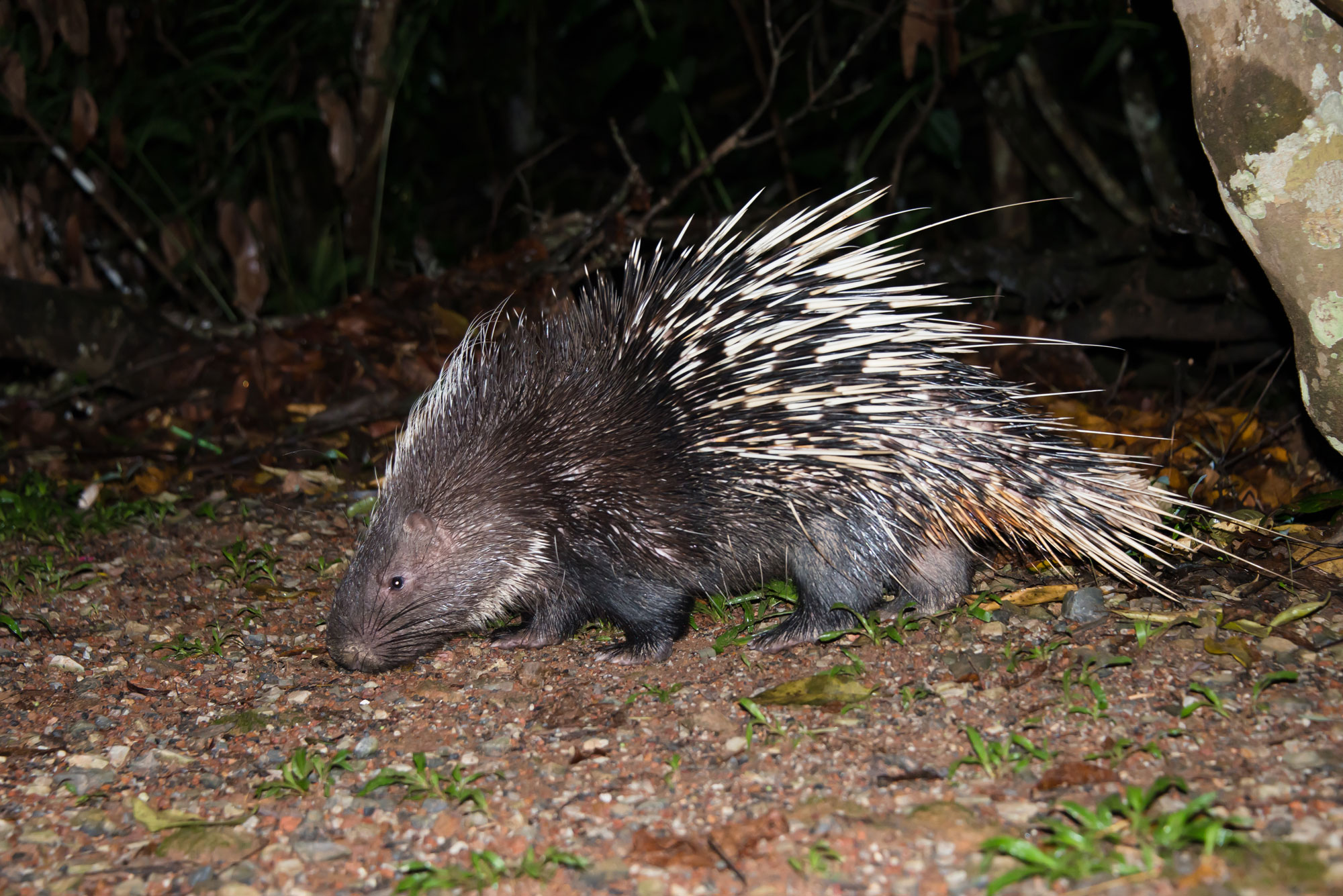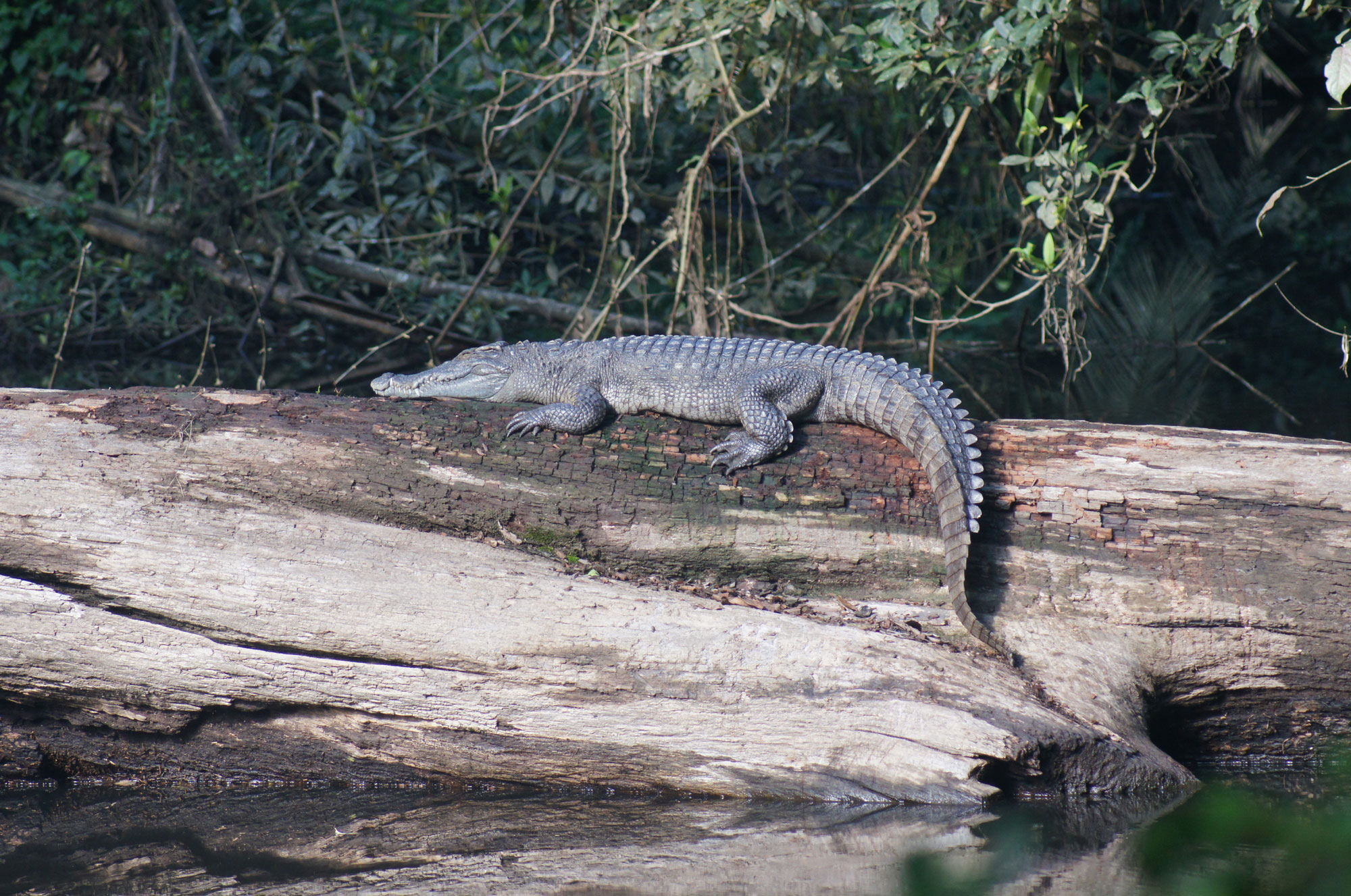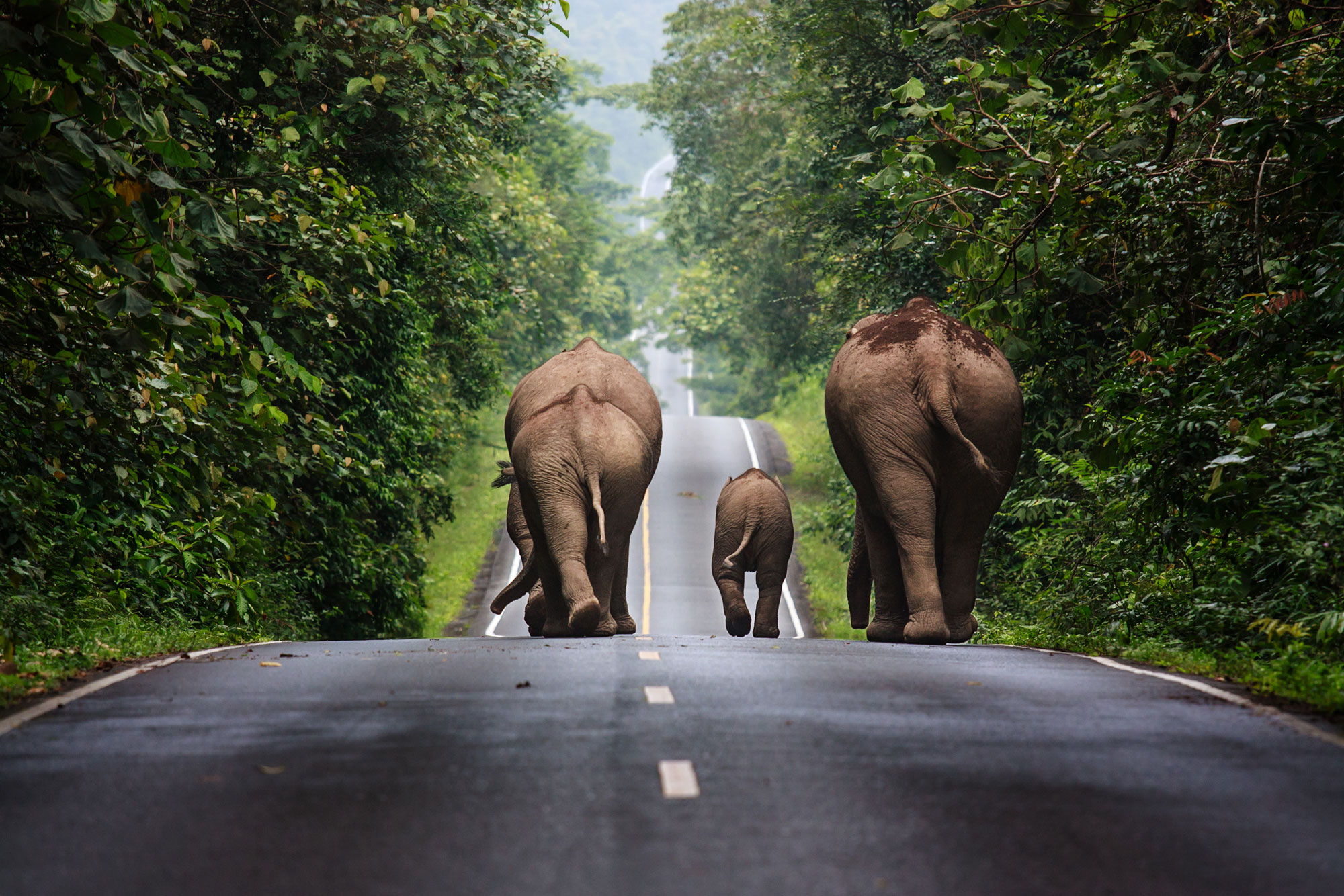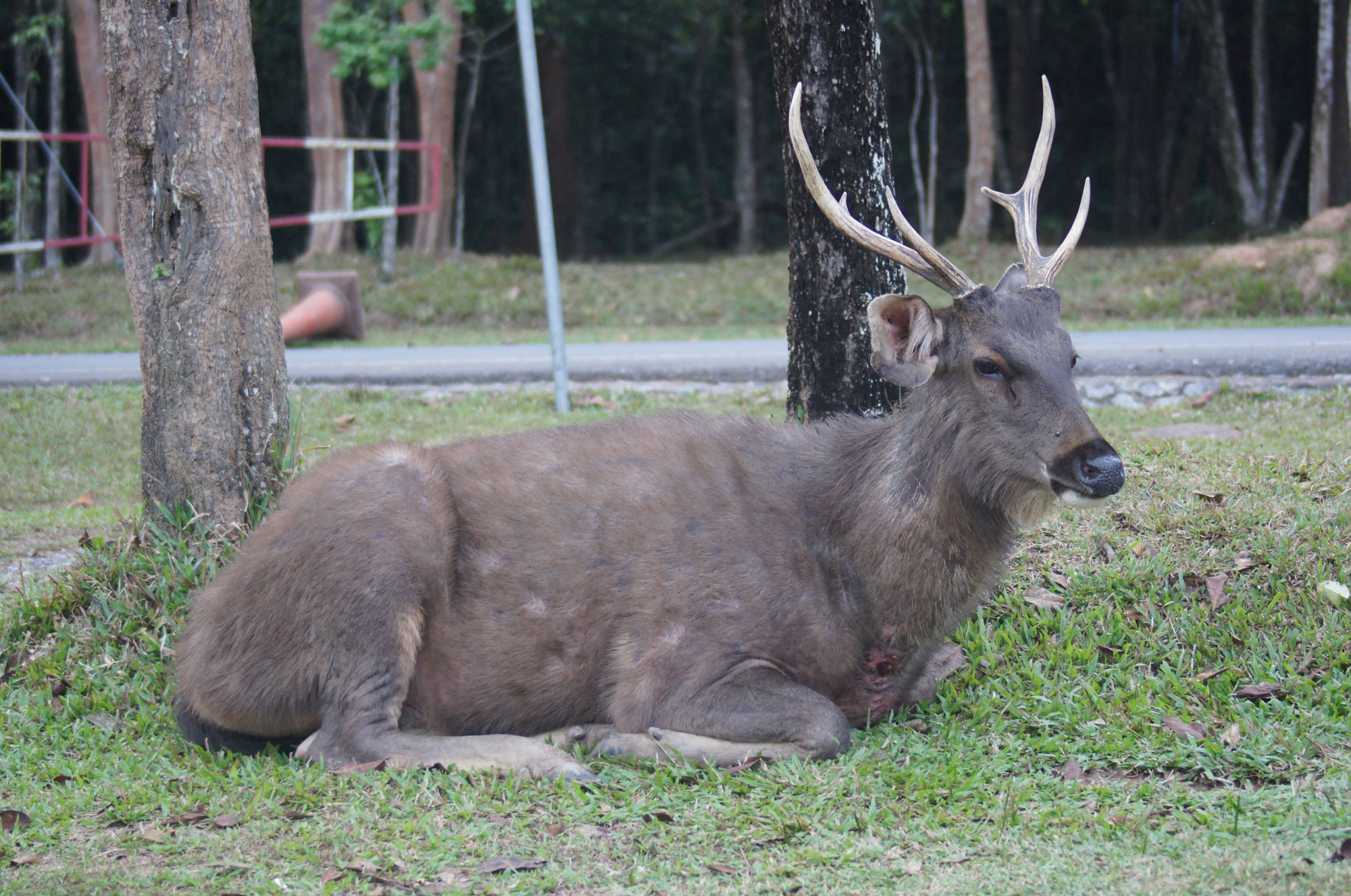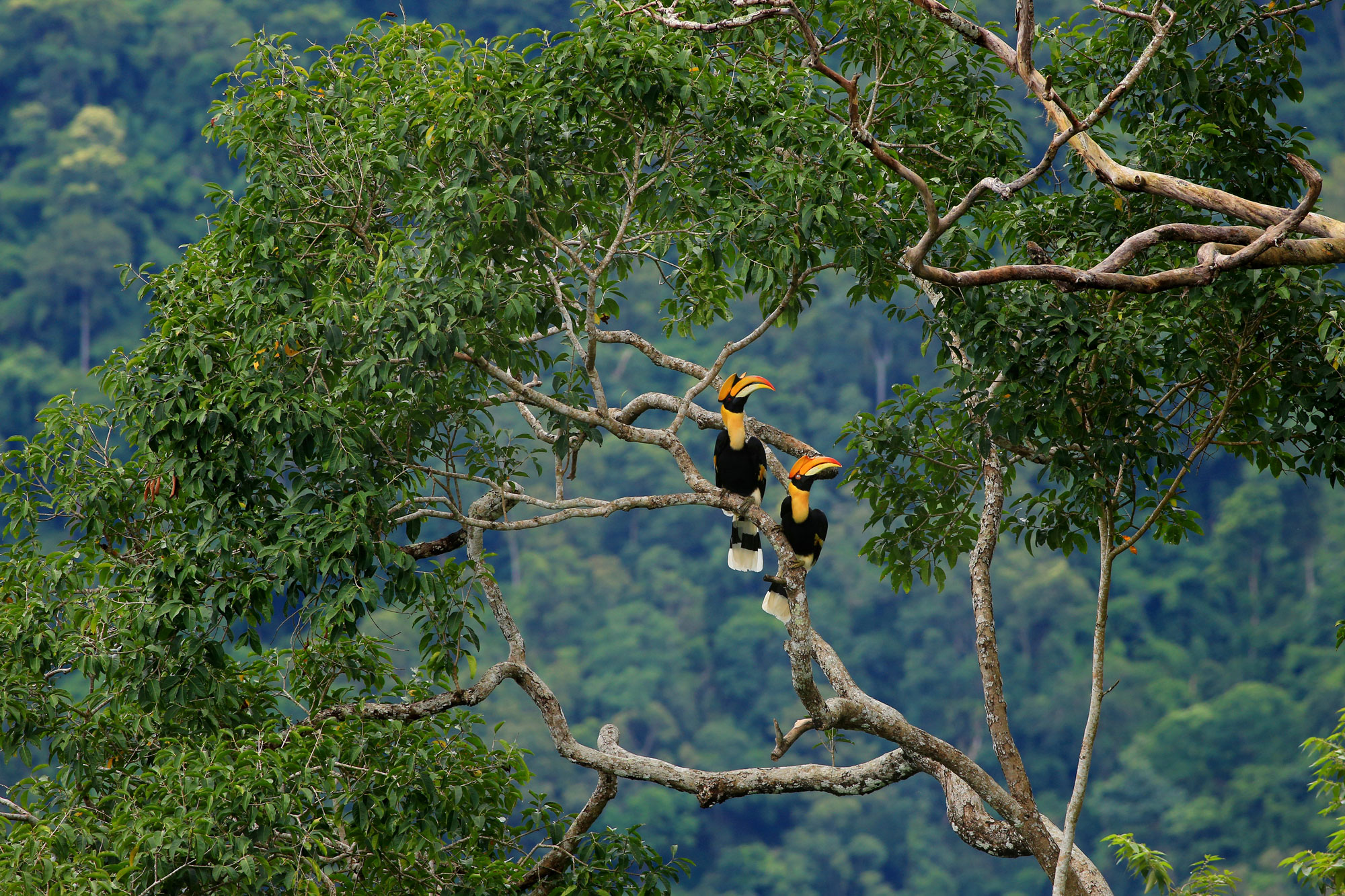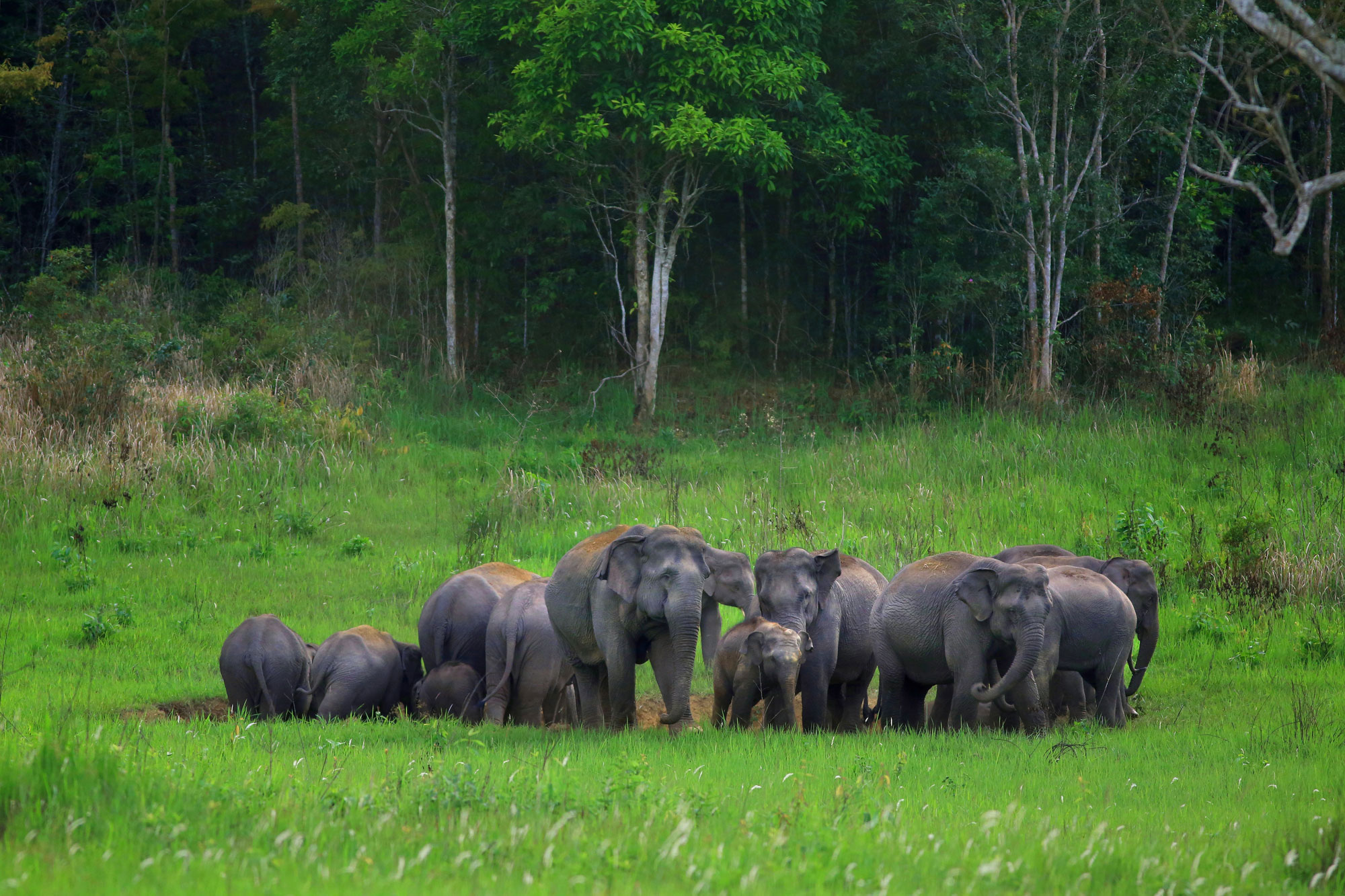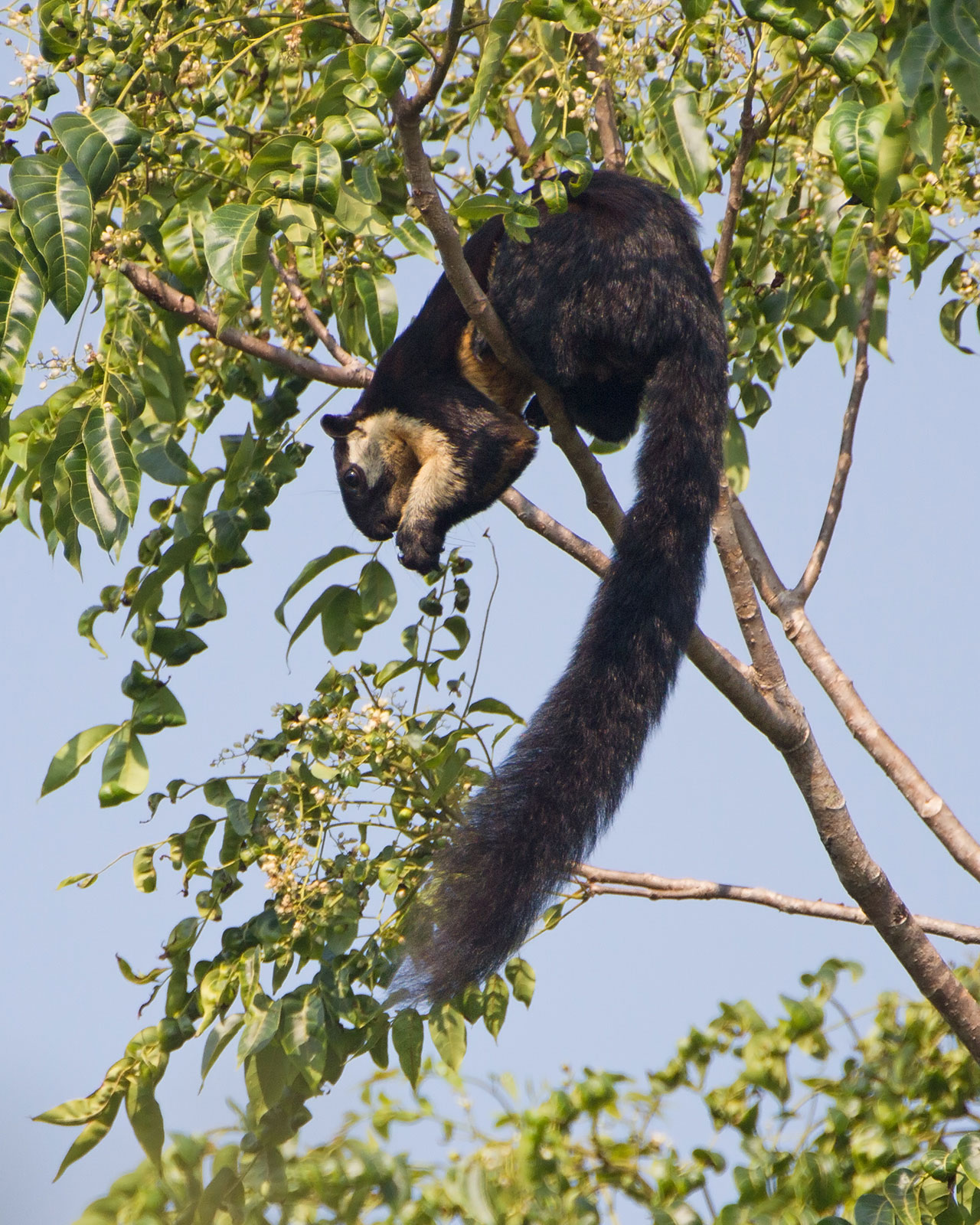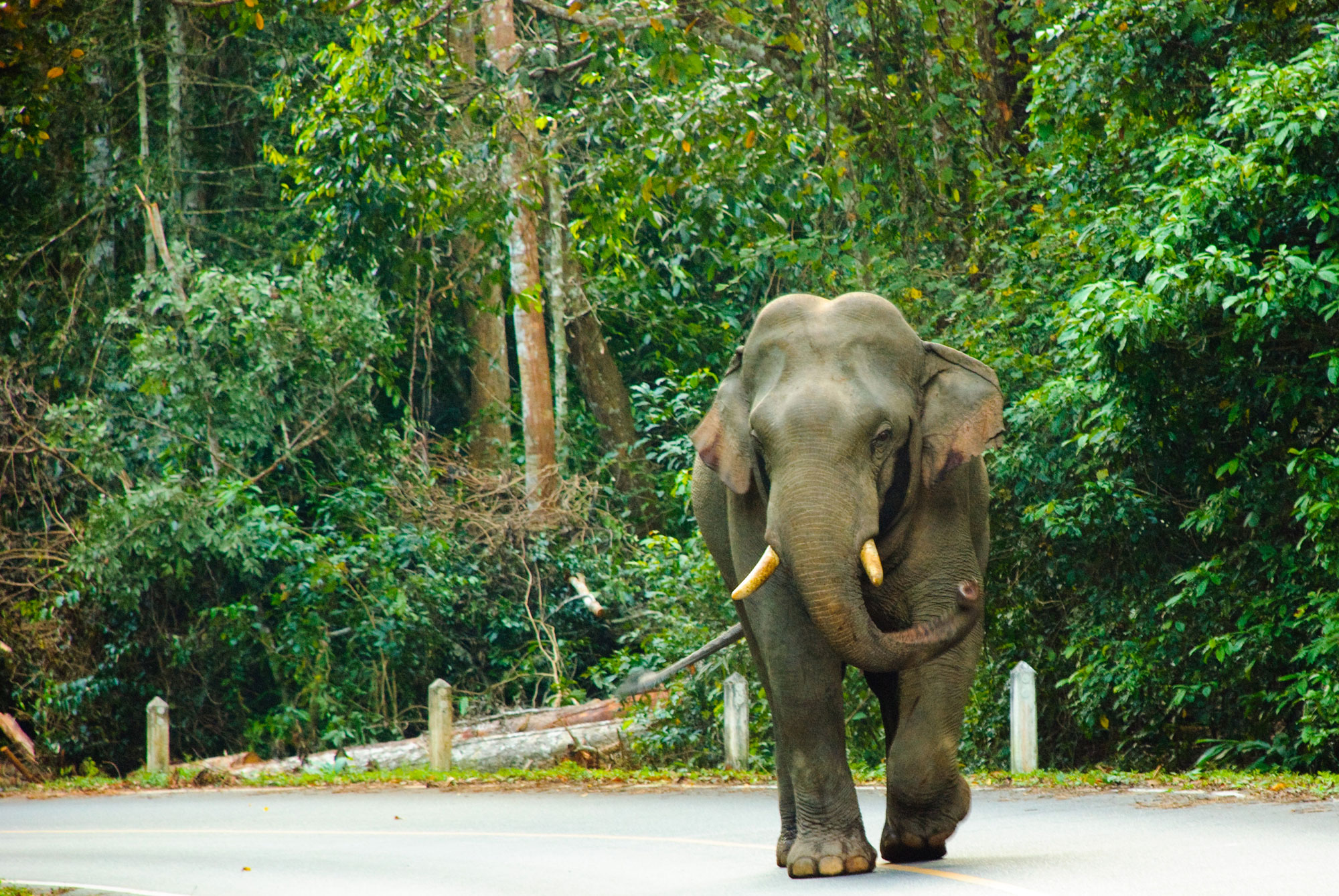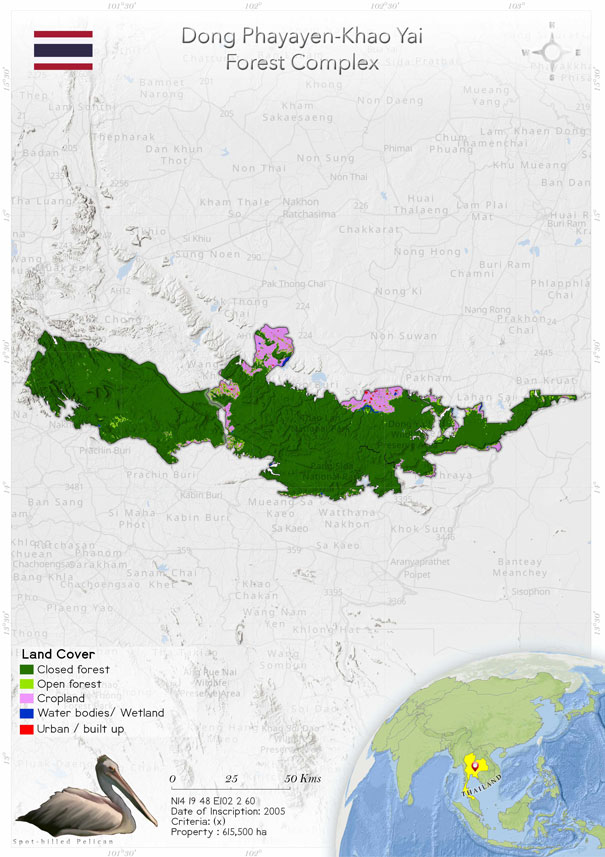
Dong Phayayen-Khao Yai Forest Complex
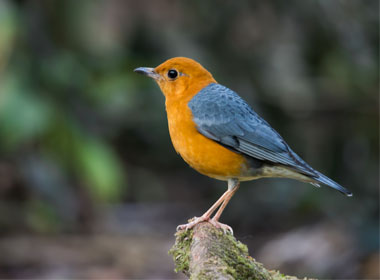 Dong Phayayen-Khao Yai forest complex is one of the largest and most important protected areas in Thailand. It is an extraordinary property as it comprises three national parks (Khao Yai, Thap Lan, Pang Sida and Ta Phraya) and one wildlife sanctuary (Dong Yai Wildlife Sanctuary). The site was recognized for the rich biodiversity, and many significant studies have been conducted on the flora and fauna, making the site ideal for in-situ conservation. The tiger (Panthera tigris corbetti), white-handed gibbon (Hylobates lar), pileated gibbon (Hylobates pileatus), Asian elephant (Elephas maximus) and gaur (Bos gaurus) are some of the endangered and globally threatened animal species of the site. The forest complex has been revoked by the presence of the highway-304, which cuts through the forest. The expansion of the two-lane highway to a four-lane highway has brought up many concerns and discussions. The State Party has been requested repeatedly to provide EIA reports to confirm the integrity of the property and protect the biodiversity of the complex and the surrounding areas. Also, land encroachment by the local communities has been addressed to prevent intrusion into the buffer zone. The ongoing process of dam installation (Huay Satone and Lam Prayathan dams are being debated) and is in need of a concrete management plan.
Dong Phayayen-Khao Yai forest complex is one of the largest and most important protected areas in Thailand. It is an extraordinary property as it comprises three national parks (Khao Yai, Thap Lan, Pang Sida and Ta Phraya) and one wildlife sanctuary (Dong Yai Wildlife Sanctuary). The site was recognized for the rich biodiversity, and many significant studies have been conducted on the flora and fauna, making the site ideal for in-situ conservation. The tiger (Panthera tigris corbetti), white-handed gibbon (Hylobates lar), pileated gibbon (Hylobates pileatus), Asian elephant (Elephas maximus) and gaur (Bos gaurus) are some of the endangered and globally threatened animal species of the site. The forest complex has been revoked by the presence of the highway-304, which cuts through the forest. The expansion of the two-lane highway to a four-lane highway has brought up many concerns and discussions. The State Party has been requested repeatedly to provide EIA reports to confirm the integrity of the property and protect the biodiversity of the complex and the surrounding areas. Also, land encroachment by the local communities has been addressed to prevent intrusion into the buffer zone. The ongoing process of dam installation (Huay Satone and Lam Prayathan dams are being debated) and is in need of a concrete management plan.
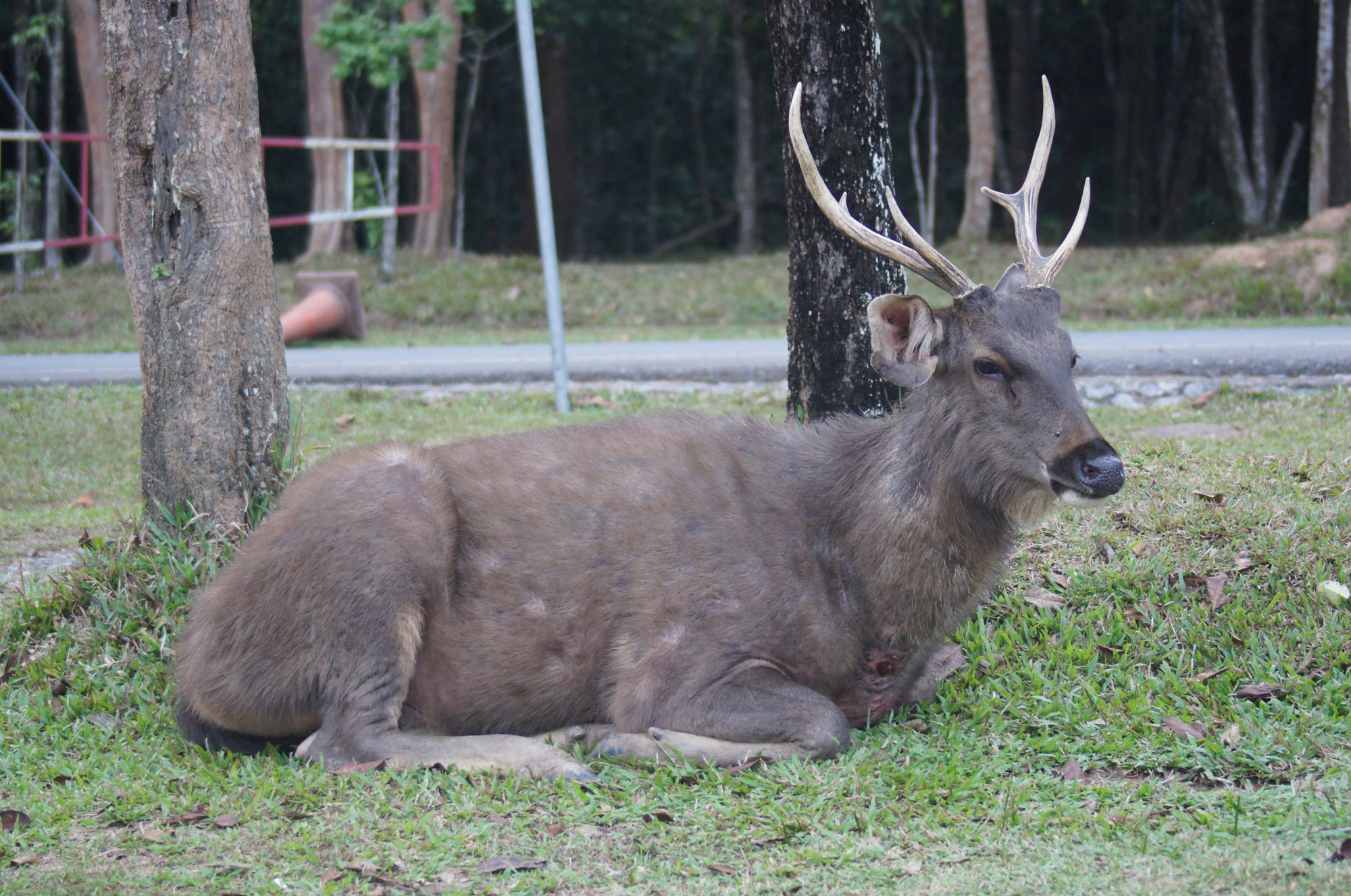 Dong Phayayen-Khao Yai Forest Complex (DPKY-FC) was declared a World Heritage Site in 2005 (Curtis & Doak, 2012). The forest complex comprises three national parks (Khao Yai, Thap Lan, Pang Sida and Ta Phraya) and one wildlife sanctuary, Dong Yai Wildlife Sanctuary (Prayurasiddhi et al. 1999). The property lies at the western end of the Phanom Dongrak escarpment, which partly delineates the Thai–Cambodian border, in four provincial areas of Nakhon Nayok, Nakhon Ratchasima, Prachin Buri and Sara Buri. It is to be noted that Khao Yai is the first national park of Thailand, having been recognised in 1961 (Lynam et al. 2006; Duengkae & Chuaynkern 2009). The average annual precipitation in DPKY-FC between 1994 and 2007 was 2200 mm (Brockelman et al. 2011).
Being a massive complex of several protected areas, the property is an excellent ground for the in-situ conservation of a very rich assemblage of plants and animals. The vegetation is tropical and dry evergreen forests with intermittent areas of mixed deciduous and bamboo forest, plantations and secondary forests (Norton & Turner 2020). A total of 3000 plant species have been recorded (Lertwannawit & Anuwichanont, 2011), including many endangered species. As many as 391 species of bird (Lynam et al 2006), 67 species of mammal, 5,000 species of insect (Lertwannawit and Anuwichanont, 2011) and 200 reptile and amphibian species (Curtis & Doak 2012).
The semi-evergreen forest in DPKY is thought to be especially significant as it is the habitat of some important endemic species such as the Siamese fireback Lophura diardi, the great slaty woodpecker (Mulleripicus pulverulentus), four species of hornbill (Bucerotidae), the coral-billed ground cuckoo (Carpococcyx renauldi), the Javan frogmouth (Batrachostomus javensis), the pompadour pigeon (Treron pompadora), the green imperial pigeon (Ducula aenea), the black eagle (Ictinaetus malayensis), the mountain hawk eagle (Spizaetus nipalensis), the Malayan night heron (Gorsachius melanolophus), the silver oriole (Oriolus mellianus), the golden-crested myna (Ampeliceps coronatus) and the hill myna (Gracula religiosa) (Lynam et al. 2006). There are 12 key species among the mammals that are found in the semi-evergreen forests. These include the tiger (Panthera tigris corbetti), the white-handed gibbon (Hylobates lar), the pileated gibbon (Hylobates pileatus), the Asian elephant (Elephas maximus), the gaur (Bos gaurus), the clouded leopard (Neofelis nebulosa), the Asian golden cat (Catopuma temminckii), the marbled cat (Pardofelis marmorata) and the southern serow (Capricornis sumatraensis) (Lynam et al. 2006).
Dong Phayayen-Khao Yai Forest Complex (DPKY-FC) was declared a World Heritage Site in 2005 (Curtis & Doak, 2012). The forest complex comprises three national parks (Khao Yai, Thap Lan, Pang Sida and Ta Phraya) and one wildlife sanctuary, Dong Yai Wildlife Sanctuary (Prayurasiddhi et al. 1999). The property lies at the western end of the Phanom Dongrak escarpment, which partly delineates the Thai–Cambodian border, in four provincial areas of Nakhon Nayok, Nakhon Ratchasima, Prachin Buri and Sara Buri. It is to be noted that Khao Yai is the first national park of Thailand, having been recognised in 1961 (Lynam et al. 2006; Duengkae & Chuaynkern 2009). The average annual precipitation in DPKY-FC between 1994 and 2007 was 2200 mm (Brockelman et al. 2011).
Being a massive complex of several protected areas, the property is an excellent ground for the in-situ conservation of a very rich assemblage of plants and animals. The vegetation is tropical and dry evergreen forests with intermittent areas of mixed deciduous and bamboo forest, plantations and secondary forests (Norton & Turner 2020). A total of 3000 plant species have been recorded (Lertwannawit & Anuwichanont, 2011), including many endangered species. As many as 391 species of bird (Lynam et al 2006), 67 species of mammal, 5,000 species of insect (Lertwannawit and Anuwichanont, 2011) and 200 reptile and amphibian species (Curtis & Doak 2012).
The semi-evergreen forest in DPKY is thought to be especially significant as it is the habitat of some important endemic species such as the Siamese fireback Lophura diardi, the great slaty woodpecker (Mulleripicus pulverulentus), four species of hornbill (Bucerotidae), the coral-billed ground cuckoo (Carpococcyx renauldi), the Javan frogmouth (Batrachostomus javensis), the pompadour pigeon (Treron pompadora), the green imperial pigeon (Ducula aenea), the black eagle (Ictinaetus malayensis), the mountain hawk eagle (Spizaetus nipalensis), the Malayan night heron (Gorsachius melanolophus), the silver oriole (Oriolus mellianus), the golden-crested myna (Ampeliceps coronatus) and the hill myna (Gracula religiosa) (Lynam et al. 2006). There are 12 key species among the mammals that are found in the semi-evergreen forests. These include the tiger (Panthera tigris corbetti), the white-handed gibbon (Hylobates lar), the pileated gibbon (Hylobates pileatus), the Asian elephant (Elephas maximus), the gaur (Bos gaurus), the clouded leopard (Neofelis nebulosa), the Asian golden cat (Catopuma temminckii), the marbled cat (Pardofelis marmorata) and the southern serow (Capricornis sumatraensis) (Lynam et al. 2006).
Criterion (x)
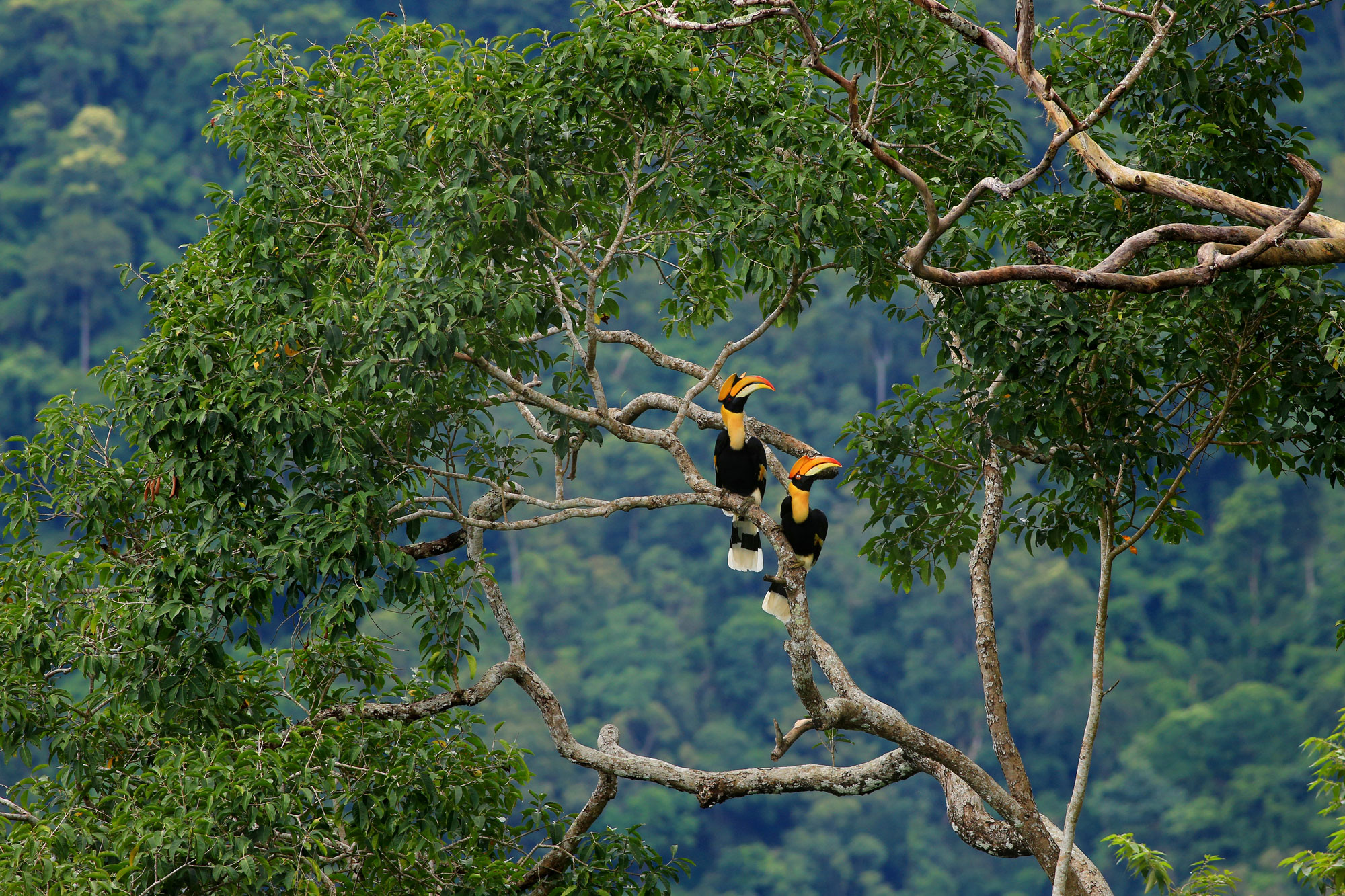 The Dong Phayayen-Khao Yai Forest Complex (DPKY-FC) contains more than 800 fauna species, including 112 species of mammals, 392 species of birds and 200 reptiles and amphibians. The property is internationally important for the conservation of globally threatened and endangered mammal, bird and reptile species that are recognised as being of outstanding universal value. This includes 1 critically endangered, 4 endangered and 19 vulnerable species. The property contains the last substantial area of globally important tropical forest ecosystems of the Thailandian Monsoon Forest biogeographic province in northeast Thailand, which in turn can provide a viable area for long-term survival of endangered, globally important species, including tiger, elephant, leopard cat and banteng. The unique overlap of the range of two species of gibbon, including the vulnerable pileated gibbon, further adds to the global value of the complex. In addition to the resident species the complex plays an important role for the conservation of migratory species, including the endangered Spot-billed Pelican and critically endangered Greater Adjutant.
The Dong Phayayen-Khao Yai Forest Complex (DPKY-FC) contains more than 800 fauna species, including 112 species of mammals, 392 species of birds and 200 reptiles and amphibians. The property is internationally important for the conservation of globally threatened and endangered mammal, bird and reptile species that are recognised as being of outstanding universal value. This includes 1 critically endangered, 4 endangered and 19 vulnerable species. The property contains the last substantial area of globally important tropical forest ecosystems of the Thailandian Monsoon Forest biogeographic province in northeast Thailand, which in turn can provide a viable area for long-term survival of endangered, globally important species, including tiger, elephant, leopard cat and banteng. The unique overlap of the range of two species of gibbon, including the vulnerable pileated gibbon, further adds to the global value of the complex. In addition to the resident species the complex plays an important role for the conservation of migratory species, including the endangered Spot-billed Pelican and critically endangered Greater Adjutant.
Status
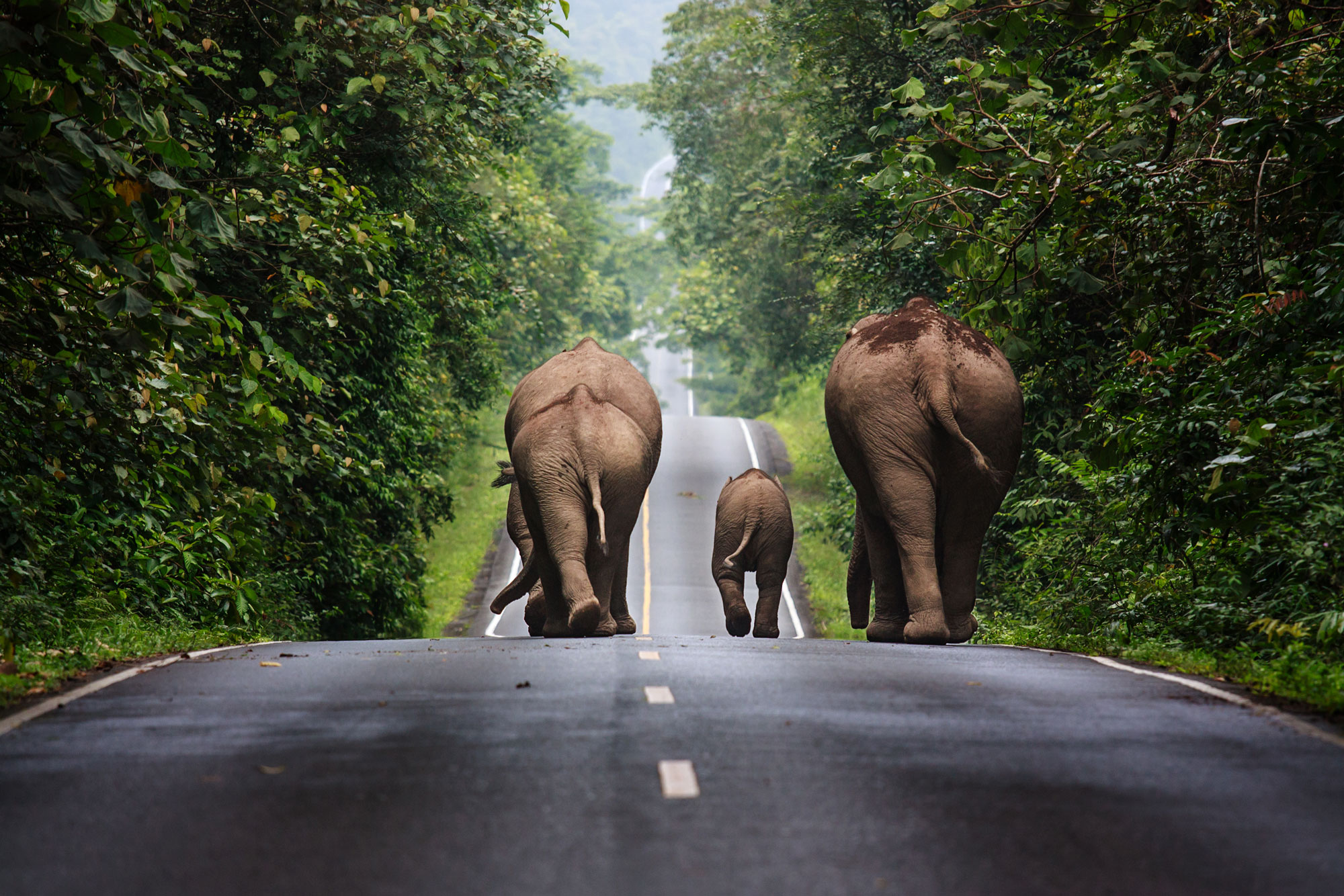 Despite being a fairly large protected area, Dong Phayayen-Khao Yai Forest Complex (DPKY-FC) has faced potential threats till recent times. The factors affecting the property include development of infrastructure, road use, poaching, encroachment, pressures from tourism and human–wildlife conflicts (Tim Redford, Freeland 2018). Since 2007, the IUCN and UNESCO have been in constant communication with the State Party regarding any concern.
Several 'State of Conservation Report' were put by the State Party to answer the queries and concerns put forward by the World Heritage Committee and the IUCN in respect to the construction of the highway-304 that separates Khao Yai National Park and Thap Lan National Park, traversing the property from north to south. In the 2007 SoC report, the heritage committee received information on the impact of highway-304 on Khao Yai National Park, including ecological fragmentation and high animal-mortality. There was also news of extension of the two-lane highway-304 to a four-lane highway that would probably cause ecological disturbances. There were many cases of road kills of animals, mostly reptiles and small mammals. Roads fragment habitats, and numerous animals are killed by vehicles when migrating and crossing roads (Coelho et al., 2008). In 2002, the carcase of a juvenile water monitor (Varanus salvator macromaculatus) was found that had been killed by a car on the forest route in Khao Yai National Park, Nakhon Ratchasima Province (Duengkae & Chuaynkern 2009).
The high mortality rates across a variety of taxa indicate a potentially high impact on a number of threatened or vulnerable species (Sodhi et al., 2004). Although the highway expansion plans do include providing several crossing points for wildlife in an effort to increase connectivity (especially under- and overpasses), their locations were not properly evaluated or tested. If this pattern stays true throughout the region, and along each major economic corridor, we could be looking at permanent environmental degradation and wildlife depletion (Ascensao et al. 2018).
Another element that adds to this disturbance caused by heavy road use is the increase in the number of tourists and the increase in tourism activities. The State Party reported that tourist visits have doubled over the past five years from 700,000 to 1.4 million in 2006. Such an increase could affect the integrity of the heritage. The National Park Wildlife and Plants Conservation Thailand Department reported that in a span of 10 years, 800,000 visitors were annually recorded in this park (2005). There also has been a rapid increase in the number of tourist vehicles in the period 2007–2008 (National Park Wildlife and Plant Conservation Department, 2008).
In 2008, the State Party was recommended to undertake an EIA regarding the highway-304 expansion and evaluate detailed pre- and post-construction monitoring data related to wildlife corridors. It was made mandatory to ensure safe wildlife movement across the national parks and reduce the mortality rates and human–wildlife conflicts.
In the 2010 SoC report, the concern about the expansion of highway-304 still remained. The State Party proposed a "mixed model" of wildlife corridors, including both elevated roads and wildlife overpasses, connecting Khao Yai National Park and Thap Lan National Park (TLNP). According to WHC and the IUCN, implementation of eco-friendly wildlife corridors would serve the purpose of maintaining the property's integrity and minimize pressure on wildlife movements in the long term.
Land encroachment occurring on the north side of Thap lan National Park has also been raising concerns at the World Heritage Committee. Indigenous people have started to claim land from within the property. Forests cover that had been converted to farmlands and open lands in the Soung Sang Area of TLNP had been converted to pasture for domestic cattle. In 2012, the State Party had provided assurance that strict measures were taken to halt the land encroachment activity in the heritage property.
Dam construction was considered to have a detrimental impact on the biodiversity and ecosystem around the site. In 2009, the construction of Huay Samong Dam was given the green signal by the State Party. Several questions and concerns were raised by the IUCN and WHC. In 2017, the State Party was overtly requested "to permanently sabotage plans for any construction of dams within reservoirs inside the property's boundaries, including the Huay Satone as well as Lam Prayathan dam projects" (WH Committee, 2017). The State Party confirmed that there will be no construction in case any negative impacts befall the OUV of the property (specifically Lam Phrayathan dam) (State Party of Thailand, 2018, 2019) To this, the State Party mentioned that the area of the property flooded on completion of the dam will serve as a protection zone against encroachment. Small check dams that were built across many streams in all the parks over the last 5 years had helped raise water tables and provide drinking sources for wildlife. However, no ecological studies appear to have been conducted prior to the building of these dams, and their ecological impact, particularly on migratory species of small fish, is unknown (IUCN Consultation, 2017).
After all the assessment of the Dong Phayayen–Khao Yai Forest Complex heritage site by the IUCN, the site has been assessed as "significant concerns" in the 2020 IUCN assessment.
Despite being a fairly large protected area, Dong Phayayen-Khao Yai Forest Complex (DPKY-FC) has faced potential threats till recent times. The factors affecting the property include development of infrastructure, road use, poaching, encroachment, pressures from tourism and human–wildlife conflicts (Tim Redford, Freeland 2018). Since 2007, the IUCN and UNESCO have been in constant communication with the State Party regarding any concern.
Several 'State of Conservation Report' were put by the State Party to answer the queries and concerns put forward by the World Heritage Committee and the IUCN in respect to the construction of the highway-304 that separates Khao Yai National Park and Thap Lan National Park, traversing the property from north to south. In the 2007 SoC report, the heritage committee received information on the impact of highway-304 on Khao Yai National Park, including ecological fragmentation and high animal-mortality. There was also news of extension of the two-lane highway-304 to a four-lane highway that would probably cause ecological disturbances. There were many cases of road kills of animals, mostly reptiles and small mammals. Roads fragment habitats, and numerous animals are killed by vehicles when migrating and crossing roads (Coelho et al., 2008). In 2002, the carcase of a juvenile water monitor (Varanus salvator macromaculatus) was found that had been killed by a car on the forest route in Khao Yai National Park, Nakhon Ratchasima Province (Duengkae & Chuaynkern 2009).
The high mortality rates across a variety of taxa indicate a potentially high impact on a number of threatened or vulnerable species (Sodhi et al., 2004). Although the highway expansion plans do include providing several crossing points for wildlife in an effort to increase connectivity (especially under- and overpasses), their locations were not properly evaluated or tested. If this pattern stays true throughout the region, and along each major economic corridor, we could be looking at permanent environmental degradation and wildlife depletion (Ascensao et al. 2018).
Another element that adds to this disturbance caused by heavy road use is the increase in the number of tourists and the increase in tourism activities. The State Party reported that tourist visits have doubled over the past five years from 700,000 to 1.4 million in 2006. Such an increase could affect the integrity of the heritage. The National Park Wildlife and Plants Conservation Thailand Department reported that in a span of 10 years, 800,000 visitors were annually recorded in this park (2005). There also has been a rapid increase in the number of tourist vehicles in the period 2007–2008 (National Park Wildlife and Plant Conservation Department, 2008).
In 2008, the State Party was recommended to undertake an EIA regarding the highway-304 expansion and evaluate detailed pre- and post-construction monitoring data related to wildlife corridors. It was made mandatory to ensure safe wildlife movement across the national parks and reduce the mortality rates and human–wildlife conflicts.
In the 2010 SoC report, the concern about the expansion of highway-304 still remained. The State Party proposed a "mixed model" of wildlife corridors, including both elevated roads and wildlife overpasses, connecting Khao Yai National Park and Thap Lan National Park (TLNP). According to WHC and the IUCN, implementation of eco-friendly wildlife corridors would serve the purpose of maintaining the property's integrity and minimize pressure on wildlife movements in the long term.
Land encroachment occurring on the north side of Thap lan National Park has also been raising concerns at the World Heritage Committee. Indigenous people have started to claim land from within the property. Forests cover that had been converted to farmlands and open lands in the Soung Sang Area of TLNP had been converted to pasture for domestic cattle. In 2012, the State Party had provided assurance that strict measures were taken to halt the land encroachment activity in the heritage property.
Dam construction was considered to have a detrimental impact on the biodiversity and ecosystem around the site. In 2009, the construction of Huay Samong Dam was given the green signal by the State Party. Several questions and concerns were raised by the IUCN and WHC. In 2017, the State Party was overtly requested "to permanently sabotage plans for any construction of dams within reservoirs inside the property's boundaries, including the Huay Satone as well as Lam Prayathan dam projects" (WH Committee, 2017). The State Party confirmed that there will be no construction in case any negative impacts befall the OUV of the property (specifically Lam Phrayathan dam) (State Party of Thailand, 2018, 2019) To this, the State Party mentioned that the area of the property flooded on completion of the dam will serve as a protection zone against encroachment. Small check dams that were built across many streams in all the parks over the last 5 years had helped raise water tables and provide drinking sources for wildlife. However, no ecological studies appear to have been conducted prior to the building of these dams, and their ecological impact, particularly on migratory species of small fish, is unknown (IUCN Consultation, 2017).
After all the assessment of the Dong Phayayen–Khao Yai Forest Complex heritage site by the IUCN, the site has been assessed as "significant concerns" in the 2020 IUCN assessment.
